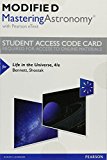
Concept explainers
The Age of Earth. Some people still question whether we have a reasonable knowledge of the age of Earth or the ability to date events in Earth’s history. Based on what you have learned about both relative and absolute ages on the geological time scale, do you think it is reasonable for scientists to be confident of ages found by radiometric dating? Is there any scientific reason to doubt the reliability of our chronology of Earth? Explain.
Want to see the full answer?
Check out a sample textbook solution
Chapter 4 Solutions
Modified Mastering Astronomy With Pearson Etext -- Standalone Access Card -- For Life In The Universe (4th Edition)
Additional Science Textbook Solutions
College Physics
Physics for Scientists and Engineers: A Strategic Approach, Vol. 1 (Chs 1-21) (4th Edition)
University Physics (14th Edition)
College Physics (10th Edition)
Essential University Physics: Volume 1 (3rd Edition)
- We believe that Venus, Earth, and Mars all started with a significant supply of water. Explain where that water is now for each planet.arrow_forwardDescribe how we use radioactive elements and their decay products to find the age of a rock sample. Is this necessarily the age of the entire world from which the sample comes? Explain.arrow_forwardIf you represent Earths history by a line that is 1 m long, how long a segment would represent the 400 million years since life first moved onto the land? How long a segment would represent the 4-millionyear history of humanoid life?arrow_forward
- Detail some of the anthropogenic changes to Earth’s climate and their potential impact on life.arrow_forwardWhy is there so little evidence of Earth’s earliest history and therefore the period when life first began on our planet?arrow_forwardDescribe the current atmosphere on Mars. What evidence suggests that it must have been different in the past?arrow_forward
- Name three locations in our Solar System to search for Earth-like life and explain your choices.arrow_forwardWhat does a planet need in order to retain an atmosphere? How does an atmosphere affect the surface of a planet and the ability of life to exist?arrow_forwardIn what ways is Earth unique among the Terrestrial planets?arrow_forward

 Stars and Galaxies (MindTap Course List)PhysicsISBN:9781337399944Author:Michael A. SeedsPublisher:Cengage Learning
Stars and Galaxies (MindTap Course List)PhysicsISBN:9781337399944Author:Michael A. SeedsPublisher:Cengage Learning Foundations of Astronomy (MindTap Course List)PhysicsISBN:9781337399920Author:Michael A. Seeds, Dana BackmanPublisher:Cengage Learning
Foundations of Astronomy (MindTap Course List)PhysicsISBN:9781337399920Author:Michael A. Seeds, Dana BackmanPublisher:Cengage Learning University Physics Volume 1PhysicsISBN:9781938168277Author:William Moebs, Samuel J. Ling, Jeff SannyPublisher:OpenStax - Rice University
University Physics Volume 1PhysicsISBN:9781938168277Author:William Moebs, Samuel J. Ling, Jeff SannyPublisher:OpenStax - Rice University Horizons: Exploring the Universe (MindTap Course ...PhysicsISBN:9781305960961Author:Michael A. Seeds, Dana BackmanPublisher:Cengage Learning
Horizons: Exploring the Universe (MindTap Course ...PhysicsISBN:9781305960961Author:Michael A. Seeds, Dana BackmanPublisher:Cengage Learning AstronomyPhysicsISBN:9781938168284Author:Andrew Fraknoi; David Morrison; Sidney C. WolffPublisher:OpenStax
AstronomyPhysicsISBN:9781938168284Author:Andrew Fraknoi; David Morrison; Sidney C. WolffPublisher:OpenStax





